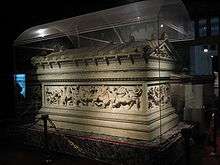Alexander Sarcophagus


The Alexander Sarcophagus is a late 4th century BC Hellenistic stone sarcophagus adorned with bas-relief carvings of Alexander the Great.[1] The work is remarkably well preserved and has been celebrated for its high aesthetic achievement. It is considered the outstanding holding of the Istanbul Archaeology Museum.[2]
History
Discovery and interpretation

The Alexander Sarcophagus is one of four massive carved sarcophagi, forming two pairs, that were discovered during the excavations conducted by Osman Hamdi Bey, an Ottoman of Greek descent and Yervant Voskan, an Ottoman of Armenian descent, at the necropolis near Sidon, Lebanon in 1887. Originally thought[3] to have been the sarcophagus of Abdalonymus (died 311 BC), the king of Sidon appointed by Alexander immediately following the Battle of Issus (333)[4] it was demonstrated convincingly by Karl Schefold[5] to have been made before Abdalonymus's death, its still-classical manner uninfluenced by the style of Lysippos. Waldemar Heckel argues that the sarcophagus was made for Mazaeus, a Persian noble and governor of Babylon.[6] According to Schefold, six Ionian sculptors' hands have been distinguished, working in an Attic idiom,[7] but according to Miller the sarcophagus was produced probably by a Rhodian workshop, in this case working at Sidon.[8]
Description
The sarcophagus is constructed of Pentelic marble retaining traces of its polychromy, in the form of a Greek temple.
The carvings on one long side of the piece depict Alexander fighting the Persians at the Battle of Issus. Volkmar von Graeve has compared the motif to the famous Alexander Mosaic at Naples, concluding that the iconography of both derives from a common original, a lost painting by Philoxenos of Eretria.[9] Alexander is shown mounted, wearing a lionskin on his head, and preparing to throw a spear at the Persian cavalry. The "historicity" of the figures accepted by von Graeve seems to Karl Schefold to be less stressed than the mythic content of battle and royal hunt, but some scholars believe that a second mounted Macedonian figure near the center represents Hephaestion, Alexander's older close friend. A third mounted Macedonian figure is often identified as Perdiccas.
The opposite long side shows Alexander and the Macedonians hunting lions together with Abdalonymus and the Persians.
The short ends lead the eye towards the mythic lion hunt: one short end portrays a scene in which Abdalonymus is hunting a panther; the other short end depicts a battle, perhaps the Battle of Gaza, in which case the pediment above that end would be showing the murder of Perdiccas. The pediment on the lid above shows Abdalonymus in battle
External links
- Hamdi Bey, Osman; Reinach, Théodore (1892), Une nécropole royale à Sidon (editio princeps)
- Hamdi Bey, Osman; Reinach, Théodore (1892), Une nécropole royale à Sidon: fouilles: Planches (Plates)
References
| Wikimedia Commons has media related to Alexander sarcophagus in the Istanbul Archaeological Museums. |
- ↑ Ancient Greece: From the Archaic Period to the Death of Alexander the Great, Britannica Educational Publishing, p.176
- ↑ Istanbul Museum numbers 72–74.
- ↑ Studniniczka Achäologische Jahrbook 9 (1894), pp 226ff; F. Winter, 1912.
- ↑ J.D. Beazley and Bernard Ashmole, (Greek Sculpture and Painting 1932, p. 59, fig. 134), Margarete Bieber ("The Portraits of Alexander" Greece & Rome, Second Series, 12.2, Alexander the Great [October 1965], pp. 183–188) and Karl Schefold (Der Alexander-Sarkophag [Frankfort/Berlin] 1968) maintain this opinion; Schefold's is the modern monograph from which more recent opinion departs; its many photographs are by Max Seidel.
- ↑ "Convincingly": Brunilde Sismondo Ridgway's review in the American Journal of Archaeology 73.4 (October 1969), p. 482.
- ↑ Heckel, Waldemar (2006). "Mazaeus, Callisthenes and the Alexander Sarcophagus". Historia. 55 (4): 385-396.
- ↑ Schefold 1968, p. 24
- ↑ Margaret C. Miller, Athens and Persia in the Fifth Century BC: A Study in Cultural Receptivity, Cambridge University Press, 2004, p.122
- ↑ Volkmar von Graeve, Der Alexandersarkophag und seine Werkstatt (Berlin) 1970; not all readers were convinced: see Christine Mitchell Havelock's review in American Journal of Archaeology 76.1 (January 1972), pp. 98–99.